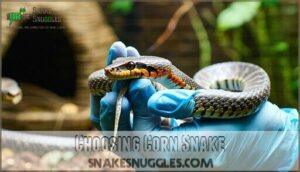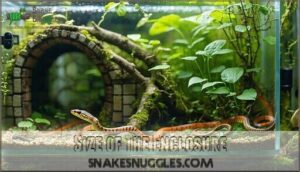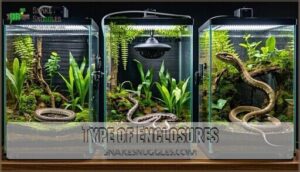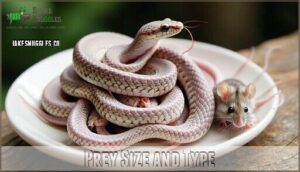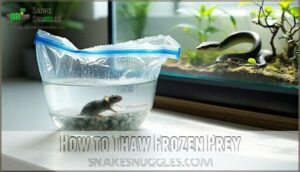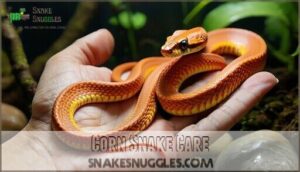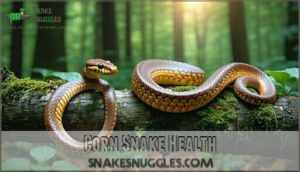This site is supported by our readers. We may earn a commission, at no cost to you, if you purchase through links.

These non-venomous, docile snakes are low-maintenance and thrive with simple care.
Set up a secure enclosure, about 20-30 gallons for adults, with a warm side around 85°F and a cool spot near 75°F.
Use aspen shavings or paper towels for bedding, and keep humidity around 40-50%.
Feed pre-killed mice weekly, based on their size, and handle them gently, and they’ll usually relax in your hands.
Watch for signs of good health, like a smooth shed or bright eyes.
Curious about making them thrive? Read on!
Table Of Contents
- Key Takeaways
- Choosing Corn Snake
- Setting Up Habitat
- Corn Snake Diet
- Corn Snake Care
- Corn Snake Health
- Frequently Asked Questions (FAQs)
- What to do when you first get a corn snake?
- What is the friendliest beginner snake?
- Do corn snakes like to be stroked?
- Are corn snakes easy to handle?
- How to care for a corn snake as a pet?
- Where can I buy a corn snake?
- Should you buy a pet corn snake?
- How do I choose a corn snake?
- How long should a corn snake be?
- Is a corn snake good for beginners?
- Conclusion
Key Takeaways
- Set up a secure enclosure with a temperature gradient (85°F warm side, 75°F cool side), proper humidity (40-60%), and safe substrate like aspen shavings.
- Feed your corn snake appropriately sized frozen-thawed mice weekly, adjusting for age, while ensuring prey is safely thawed.
- Handle your corn snake calmly and regularly to build trust, but avoid sudden movements to keep it stress-free.
- Keep the habitat clean, sanitize water bowls and hides, and ensure annual vet checkups to maintain health and spot potential issues early.
Choosing Corn Snake
When choosing a corn snake, start by finding a reputable breeder or seller who prioritizes healthy, well-cared-for animals.
Look for a snake that’s alert, active, and free of visible signs of illness or injury.
Where to Buy a Corn Snake
When you’re choosing a beginner snake pet like a corn snake, start by exploring reputable sources.
Each has its perks:
- Reputable Breeders: Offer healthy snakes and expert advice.
- Local Reptile Shops: Affordable snake pets with trusted care tips.
- Online Retailers: Wide morph selection, but check reviews first.
- Adoption Options: Rescues give homes to snakes in need.
- Classifieds: Local listings can save on shipping, but verify health proof.
Choose wisely to simplify your reptile pet guide.
How to Select a Healthy Corn Snake
How do you pick the perfect beginner snake pet? Start by observing its activity level—you want a lively, curious snake.
Check scale condition for smoothness and snake health signs like clear eyes and no nasal discharge. A healthy body weight, not too thin, is vital.
Verify the breeder’s reputation is solid to avoid issues with corn snake care. Morph considerations are fun, but health and snake behavior matter most.
A healthy corn snake is your best start! Remember that they need appropriate sized prey every few weeks, which is crucial for their well-being.
Setting Up Habitat
Creating the perfect habitat for your corn snake is essential to keeping it healthy and stress-free.
Focus on proper enclosure size, temperature, humidity, and safe substrate to mimic its natural environment.
Size of The Enclosure
For a proper snake habitat setup, start with a hatchling enclosure of at least 10 gallons.
Adult corn snakes need a vivarium of 40+ gallons to meet enrichment needs.
Include some vertical space for climbing, as they’re natural explorers.
Plan for future upgrades as your snake grows. A larger snake enclosure guarantees comfort and promotes healthy behavior.
Type of Enclosures
When choosing a snake enclosure, safety and comfort matter.
Corn snakes thrive in various setups:
- Glass tanks: Durable and visually appealing, they’re excellent for monitoring your snake’s environment.
- Wooden vivariums: Retain heat well but need proper ventilation.
- Custom builds: Perfect for creativity, fitting arboreal setups or bioactive enclosures with terrarium backgrounds.
Always make certain enclosure security to prevent escapes. It’s vital to maintain proper humidity for the snake’s health.
Substrate Options
With enclosures covered, let’s talk about snake bedding.
Good reptile substrate options include paper substrates, cypress mulch, coconut husk, or aspen shavings.
Steer clear of avoided substrates like pine or cedar—they can harm your snake.
Consider reptile substrate options for a healthy habitat.
Aim for at least 1-2 inches of substrate depth to encourage burrowing.
Your choice shapes their comfort and health in the reptile habitat.
Temperature Gradient
After picking the right substrate, focus on the temperature gradient.
Set a basking spot at 85°F-90°F using a heat lamp.
Keep the cool side around 75°F-82°F, and night temperatures just above 70°F.
Use a thermostat to regulate heat sources and an infrared thermometer for accurate monitoring.
Consistent temperatures require reliable thermostat options.
These tools guarantee your corn snake stays stress-free and healthy.
Humidity Levels
Humidity keeps your corn snake comfy and healthy, especially during shedding.
Aim for 40-60%. Use a hygrometer to monitor levels.
To adjust humidity:
- Add a damp hide with sphagnum moss.
- Spray the enclosure lightly (avoid overwatering).
- Use a water dish near the warm side.
- Improve ventilation if humidity gets too high to prevent health problems.
Corn Snake Diet
Feeding your corn snake is simple once you know what they need. Stick to frozen-thawed mice or rats sized appropriately for their body, and you’ll keep them healthy and happy.
Feeding Frequency
Corn snakes thrive on a consistent feeding schedule.
Hatchlings eat every 5-7 days while adults do well every 10-14 days.
Adjust for seasonal changes or obesity prevention.
Avoid overfeeding to prevent regurgitation or refeeding syndrome.
Stick to frozen mice for a healthy snake diet.
Thaw frozen prey before feeding to mimic live conditions for easier consumption.
Prey Size and Type
Choosing the right prey matters for your snake’s diet.
Always size prey to be no more than 1.5 times your snake’s body width.
Frozen mice are best since live vs. frozen feeding raises safety and ethical concerns.
Reputable sources offer prey with good rodent nutritional value.
For quality options, consider snake frozen prey.
To enhance health, you can explore prey gut loading before feeding.
How to Thaw Frozen Prey
Thaw frozen prey safely in warm water to retain nutrients and ensure proper temperature for your corn snake’s health.
To thaw frozen prey safely, place the mice in a sealed bag and submerge it in warm water until it matches room temperature.
This method guarantees proper prey temperature and retains nutrients.
Avoid microwaves as they can cook the prey unevenly.
Never refreeze thawed prey—it’s a safety concern that affects your snake’s diet and overall health.
Consider cold water thawing for superior safety.
Corn Snake Care
Taking care of a corn snake means keeping its habitat clean, maintaining proper temperatures, and handling it safely.
With the right attention to its needs, your snake will stay healthy and thrive for years.
Handling and Restraint
Handling your corn snake is enjoyable when done right.
Always approach calmly for safe handling, supporting its body fully to reduce stress.
Handling frequency should start a few times weekly, gradually increasing as it adjusts.
Avoid sudden jerks to prevent bite risks.
Proper restraint means gentle holding, not squeezing—corn snakes are docile snakes, but beginners should remain mindful of safe handling and proper restraint to ensure a positive experience.
Habitat Cleaning and Maintenance
After handling your snake, keep its home spotless.
Replace substrate weekly to manage odor and bacteria.
Sanitize enclosures with reptile-safe disinfectants, not household cleaners.
Check for mold around hides to prevent health risks.
Wash water bowls daily to maintain fresh water sanitation.
Clean enrichment toys to avoid grime buildup.
Stable humidity and temperature guarantee a healthy, comfortable environment.
Annual Veterinary Checkups
Regular veterinary care supports your snake’s long-term health.
Schedule annual checkups with an exotic vet to monitor for hidden snake health issues.
Vet visit prep includes transporting your corn snake securely in a ventilated container.
Preventative care saves money compared to emergency vet visits for common illnesses.
Discuss costs of reptile veterinary care upfront to stay informed.
Corn Snake Health
Keeping your corn snake healthy starts with knowing what’s normal and spotting signs of illness early.
By staying attentive to their behavior and appearance, you can address potential issues before they become serious.
Signs of Health and Illness
A healthy corn snake has clear eyes (except during shedding), smooth scales, and steady weight.
Watch for issues like respiratory infections, scale rot, or mite infestations.
Persistent weight loss, labored breathing, or irregular shedding can signal common illnesses.
Always check their behavior—activity, appetite, and shedding patterns reflect snake health.
Quick action and proper veterinary care keep them thriving, ensuring proper veterinary care is crucial for their well-being.
Common Health Issues
Respiratory infections, scale rot, and mouth rot are common snake diseases you might face.
Mite infestations and parasites can trouble your corn snake, too.
Keep enclosures clean to avoid health issues.
Watch for signs like wheezing or abnormal behavior.
Prevent metabolic bone disease with UVB lighting.
Always prioritize reptile health—small issues can escalate without proper snake veterinary care.
Maintaining proper humidity can help prevent corn snake shedding issues.
This is crucial for overall snake health and to avoid corn snake diseases.
When to Call a Vet
Watch for signs like sudden behavioral changes, lack of appetite, or unusual shedding. Some emergency signs include respiratory issues, swollen scales, or mouth sores.
Here’s when to call a vet:
- Persistent weight loss or lethargy.
- Breathing with an open mouth.
- Difficulty passing waste.
- Visible wounds or infections.
Scheduled checkups and preventative care improve reptile health, and it’s crucial to monitor for signs like respiratory issues and sudden behavioral changes to ensure the well-being of your pet.
Frequently Asked Questions (FAQs)
What to do when you first get a corn snake?
When you first get a corn snake, set up its habitat with proper temperature, hides, and secure enclosure.
Let it acclimate for a week before handling.
Feed thawed prey after settling to avoid stress.
What is the friendliest beginner snake?
Corn snakes are one of the friendliest beginner snakes.
They’re calm, easy to handle, and don’t mind interactions.
With the right care and setup, they’ll become the ideal low-maintenance, long-term reptile companion.
Do corn snakes like to be stroked?
Imagine gently stroking a corn snake.
While they tolerate handling, they don’t enjoy petting like cats or dogs.
Your snake views touch neutrally, so handle them calmly and briefly to avoid stress.
Are corn snakes easy to handle?
Yes, they’re easy to handle if you’re calm and patient.
Their docile temperament makes them great for handling, but avoid sudden movements.
Let them explore your hands naturally to build trust over time.
How to care for a corn snake as a pet?
Provide a secure, escape-proof enclosure with temperature gradients, hides, and proper humidity.
Feed thawed mice weekly, and clean regularly to maintain a healthy environment.
Handle them gently to build trust, and research their needs—they’re low-maintenance but need consistent, thoughtful care.
Where can I buy a corn snake?
Seeking a slithery sidekick? Check out reptile expos, specialized breeders, or pet stores with solid reputations.
Always research the seller’s care standards and health guarantees to guarantee your corn snake’s journey starts smooth and secure.
Should you buy a pet corn snake?
Buying a pet corn snake is a great choice if you’re ready for a low-maintenance, long-term companion.
They’re docile, easy to care for, and suited to beginners.
But remember—they live over 20 years!
How do I choose a corn snake?
Imagine this: you spot a vibrant, healthy corn snake with clear eyes, smooth scales, and an active demeanor.
Choose one eating well, from a reputable breeder or store, for a great start to ownership.
How long should a corn snake be?
A fully grown corn snake usually measures 4 to 6 feet long.
They start at around 8-12 inches as hatchlings and grow steadily over a few years.
Their slender body makes handling easy.
Is a corn snake good for beginners?
It’s no accident that corn snakes are wildly popular with beginners.
Their calm nature, easy care, and manageable size make them perfect for first-timers.
They’re like the goldfish of the snake world—simple yet enchanting.
Conclusion
Imagine holding your calm, healthy corn snake as it explores your hand—proof of your care paying off.
With the right enclosure, steady temperatures, proper humidity, and weekly feeding, your corn snake for beginners isn’t just easy to maintain, it thrives.
Don’t skip regular habitat cleaning or observing for health signs like shedding and bright eyes.
These simple steps keep your snake healthy and happy, making it a rewarding experience for you both, where success starts here with proper care, and your snake remains healthy.

